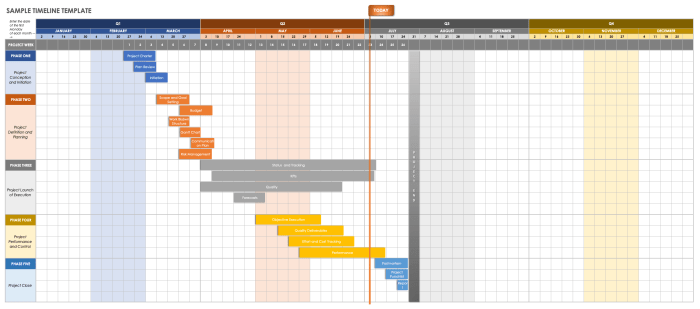Project Timeline Excel Mastering Project Management
Effective project management hinges on precise timelines. This comprehensive guide delves into the power of Microsoft Excel for crafting and managing project timelines, offering a structured approach for success. From foundational concepts to advanced techniques, this resource empowers project managers to create dynamic, insightful, and actionable timelines within Excel.
The guide explores various aspects of project timeline management within Excel, including the creation of basic timelines, incorporating formulas and functions for calculations, and the visualization of timelines through Gantt charts. It also emphasizes the importance of managing dependencies and resources effectively, identifying common errors, and showcasing practical templates for diverse project types. By mastering these strategies, project managers can ensure projects stay on track, resources are optimized, and deliverables are met on time.
Introduction to Project Timelines
Project timelines are crucial for successful project management. They provide a structured roadmap outlining the schedule of tasks, milestones, and deadlines. Understanding the concept and importance of timelines is fundamental to planning and executing projects effectively, regardless of the project’s size or complexity. Different project types employ timelines in various ways, reflecting the unique characteristics and requirements of each project.
Importance of Project Timelines
- Improved Planning and Organization: Timelines provide a clear visualization of project tasks and their dependencies, facilitating better planning and organization.
- Enhanced Communication and Collaboration: Timelines serve as a shared understanding of the project’s schedule, promoting better communication and collaboration among team members and stakeholders.
- Reduced Risk and Delays: Identifying potential delays and dependencies early on through timelines allows for proactive mitigation strategies.
- Improved Resource Allocation: Timelines help in optimizing resource allocation by showing when specific resources are needed.
- Increased Project Visibility: Timelines provide transparency, enabling stakeholders to monitor project progress and understand potential bottlenecks.
Common Challenges in Managing Project Timelines
- Unrealistic Deadlines: Setting overly ambitious deadlines can lead to stress and potential project failure.
- Lack of Task Prioritization: Improper prioritization of tasks can cause bottlenecks and delays.
- Insufficient Resource Allocation: Inadequate resources can impede progress and delay project completion.
- Poor Communication: Lack of effective communication can lead to misunderstandings and delays.
- Unexpected Issues: Unforeseen circumstances such as equipment failures or personnel changes can disrupt timelines.
Benefits of a Structured Approach to Project Timelines

- Enhanced Efficiency: A structured approach to timeline management ensures tasks are completed on schedule.
- Improved Predictability: A structured timeline provides better visibility into project progress, leading to more predictable outcomes.
- Reduced Cost Overruns: Effective timeline management helps avoid unnecessary delays and costs.
- Higher Project Success Rates: Timelines contribute to a higher likelihood of project completion within the planned timeframe and budget.
Excel for Project Timeline Management
Microsoft Excel offers a robust platform for managing project timelines. Its spreadsheet structure and built-in functions make it a versatile tool for tracking tasks, dependencies, and deadlines. Excel’s features are well-suited to project timelines, allowing for the creation of visual representations of project progress and potential bottlenecks.
Features of Excel for Project Timelines
- Spreadsheet Structure: Excel’s spreadsheet format allows for easy organization of project data.
- Formula Support: Excel’s extensive formula library allows for automatic calculations of durations, deadlines, and dependencies.
- Charting Capabilities: Excel’s charting tools, particularly Gantt charts, can visualize project timelines effectively.
- Data Analysis: Excel allows for data analysis to identify trends, risks, and potential delays.
- Widely Available and Familiar: Most project managers have experience with Excel, making it a familiar and accessible tool.
Methods for Creating Project Timelines in Excel
- Simple Task List: A basic list of tasks with start and end dates.
- Gantt Chart: A visual representation of tasks, their durations, and dependencies.
- Milestone-Based Timeline: Highlighting key project milestones with associated dates.
Common Errors in Excel Project Timelines
- Inaccurate Data Entry: Mistakes in entering task durations or deadlines.
- Missing Dependencies: Failing to account for dependencies between tasks.
- Poor Visualization: Unclear or confusing visualizations of the timeline.
Best Practices for Organizing Project Timelines in Excel
- Clear and Concise Data: Use clear and concise terminology.
- Consistent Formatting: Maintain consistent formatting throughout the timeline.
- Proper Data Validation: Implement data validation rules to ensure accuracy.

